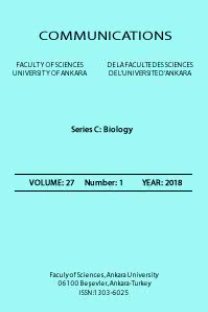EFFECT OF SALINITY AND LIGHT ON GERMINATION OF SALSOLA GRANDIS FREITAG, VURAL & N. ADIGUZEL (CHENOPODIACEAE)
Öz Salsola grandis (Chenopodiaceae) is a xero-halophytic and local endemic species from Nallıhan-Turkey and has IUCN threat category of CR. The aim of the study was to determine the influence of light and salinity on germination of S. grandis which could be the explanation of the small population size and distribution area. Seeds were collected at fall of 2011 and used without perianth segments. All the trials were conducted at (12 h/12 h) 20/8 ºC day and night temperature regime. For the influence of salinity different NaCl concentrations were used, distilled water (as control), 100, 200, 300, 400, 500, 600 and 800 mM NaCl. Seeds that did not germinate under saline conditions were taken into recovery tests. After recovery the un-germinated seeds were tested for viability with TTC test. As a result light did not have any influence on germination. As in other halophytes increase in NaCl concentration results decrease in germination ratio. The best germination was observed in distilled water. Although salinity repress the germination of S. grandis seeds even at 800 mM NaCl there was 11.6% germination percentage, so it can be concluded that the seeds of S. grandis are salt tolerant
Anahtar Kelimeler:
Chenopodiaceae, Salsola grandis, Endemic, Xero-halophyte, Germination
___
M. A. Khan, G. Bilquees and D. J. Weber. Seed germination in the Great Basin halophyte Salsola iberica. Canadian Journal of Botany. 80 (2002) 654-655.R. F. Parsons. Incidence and ecology of very fast germination. Seed Science Research. 22 (2012) 161-167.
H. Freitag, M. Vural and N. Adiguzel. A remerkable new Salsola and Chenopodiaceae from Central Anatolia, Turkey, Willdenowia 29 (1999) 123-139.
Y. Wei, M. Dong, Z.Y. Huang and D.Y. Tan. Factors influencing seed germination of Salsola affinis (Chenopodiaceae) a dominant annual halophyte inhabiting the deserts of Xinjiang, China. Flora 203 (2008) 134-140.
M. T. Aiazzi, J.A. Arguello. Dormancy and germination studies on dispersal units of Atriplex cordobensis Gandoger & Stucker (Chenopodiaceae). Seed Science & Technology 20 (1992) 401-407.
K. Takeno and H. Yamaguchi. Diversity in seed germination behaviour in relation to heterocarpy in Salsola komarovii Illjin. Botanical Magazine, Tokyo 104 (1991) 07-215.
A. Wallace, W. A. Rhods and E.F. Frolich. Germination behaviour of Salsola as influenced by temperature, moisture, depth of planting and gamma irradiation. Agronomy Journal. 60 (1968) 76-78.
M. Greenfield. Histology of Salsola kali L. var. tenuifolia G. F. W. May. Kansas Univ. Sci. Bull. 7 (1913) 263-73.
I. A. Ungar. Seed germination and seed bank ecology in halophytes. In seed development and seed germination. Edited by J. Kigel and G. Galili. Marcel Dekker. New York. Pp: (1995) 599-628.
S. R. J. Woodell. Salinity and seed germination patterns in coastal plants. Vegetatio. 61 (1985) 223-229.
S. Mohammad and D. N. Sen. Germination behaviour of some halophytes in Indian desert. Indian Journal of Experimental Biology. 28 (1990) 545-549.
A. Assaeed. Effect of temperature and water potential on germination of Salsola villosa Del. ex. Roem. Et Schult. Assiut Journal of Agricultural Science. 32 (2001) 173-183.
S.A. Al-Khateeb. Differential response of Seidlitzia rosmarnus L. and Salsola chandharly L. to NaCl induced salinity under eastern Saudi Arabian conditions. Pakistan Journal of Agricultural Research. 17 (2002) 81-87.
A. El-Keblawy, F. Al-Ansari, N. Hassan and N. Al-Shamsi. Salinity, temperature and light affect germination of Salsola imbricate. Seed Science and Technology. 35 (2007) 272-281.
Mehrun-Nisa, M.A. Khan and D. J. Weber. Dormancy, germination and viability of Salsola imbricata seeds in relation to light, temperature and salinity. Seed Science and Technology, 35 (2007) 595-606.
C. C. Baskin and J. M. Baskin. Seeds: Ecology, biogeography and evolution of dormancy and germination, Academic Press. San Diego, (1998) 666 pp.
M. A. Khan and I. A. Ungar. The effect of salinity and temperature on the germination pf polymorphic seeds and growth of Atriplex triangularis Willd. American Journal of Botany. 71 (4): (1984) 481- 489.
H. Zhang, G. Zhang, X. Lü, D. Zhou and X. Han. Salt tolerance during seed germination and early seedling stages of 12 halophytes. Plant Soil 388 (2015) 229-241.
A. H. L. Huiskes, A. W. Stienstra, B. P. Koutataal, M. M. Markusse and J. Van Soelen. Germination ecology of Salicornia dolichostachya and S. brachystacya, Acta Bot. Neerl, 34, 4 (1985) 369-380.
M. A. Khan and I. A. Ungar. Effects of thermoperiod on recovery of seed germination of halophytes from saline conditions, Am. J. Bot., 84, 2 (1997) 279-283.
M. A. Khan, B. Gul. High salt tolerance in germinating dimorphic seeds of Arthrocnemum indicum, International Journal of Plant Sciences, 159, (1998) 826-832.
M. A. Khan, G. Bilquees and D. J. Weber. Temperature and high salinity effects in germinating dimorphic seeds of Atriplex rosea, Western North American Naturalist, 164, 2 (2004) 193-201.
A. H. Sekmen, F. Ozdemir and I. Turkan. Effects of salinity, light and temperature on seed germination in a Turkish endangered halophyte, Kalidiopsis wagenitzii (Chenopodiaceae), Israel Journal of Plant Sciences, 52, (2004) 21-30.
I. A. Ungar. Halophyte seed germination, The Bot. Rev., 44 (1978) 233- 264.
L. Wang, Z. Huang, C. C. Baskin, J. M. Baskin and M. Dong. Germination of dimorphic seeds of desert annual halophyte Suaeda aralocaspica (Chenopodiaceae), a C4 plant without kranz anatomy. Ann. Bot., 102 (2008) 757-769.
I. B. Cınar, G. N. Tug. The Morphology, Ecology, and Conservation Status of the Local Endemic Species Salsola grandis. Ekoloji 24(96) (2015) 41-47.
- ISSN: 1303-6025
- Yayın Aralığı: Yılda 2 Sayı
- Başlangıç: 1943
- Yayıncı: Ankara Üniversitesi
Sayıdaki Diğer Makaleler
Engin SELVİ, Teoman KANKILIÇ, Perinçek Seçkinozan ŞEKER, Ercüment ÇOLAK
İnci Bahar ÇINAR, Gül AYYILDIZ, Ahmet Emre YAPRAK, Gül Nilhan TUĞ
A NEW RECORD OF OPHIOBOLUS Riess FOR TURKEY
Faruk SELÇUK, Tuğba GÜNDOĞAN, İlgaz AKATA
İnci Bahar ÇINAR, Gül AYYILDIZ, Ahmet Emre YAPRAK, Gül Nilhan TUĞ
